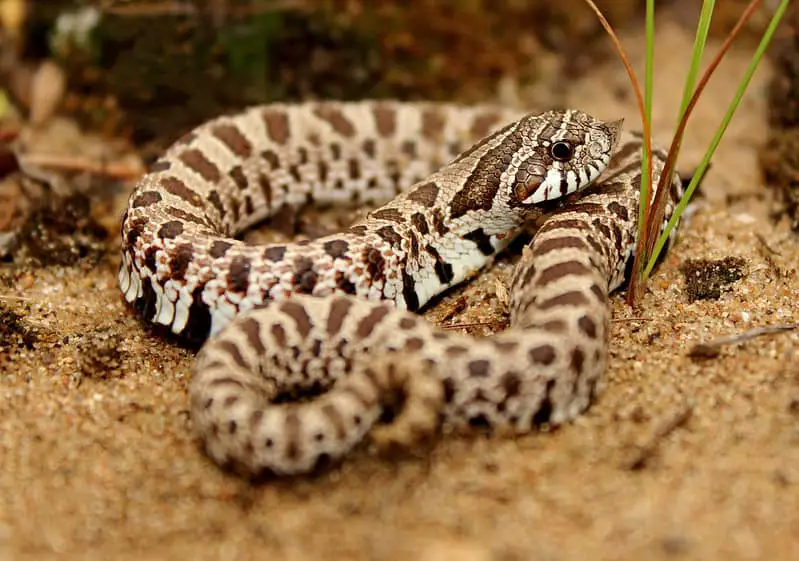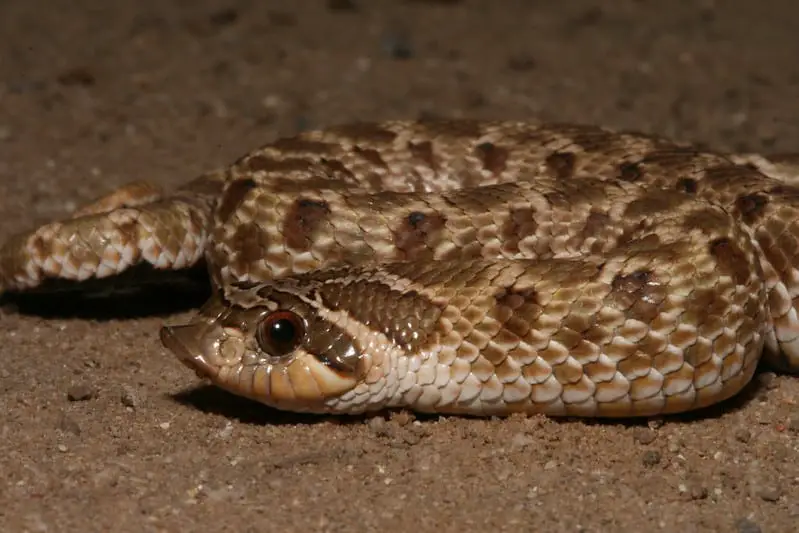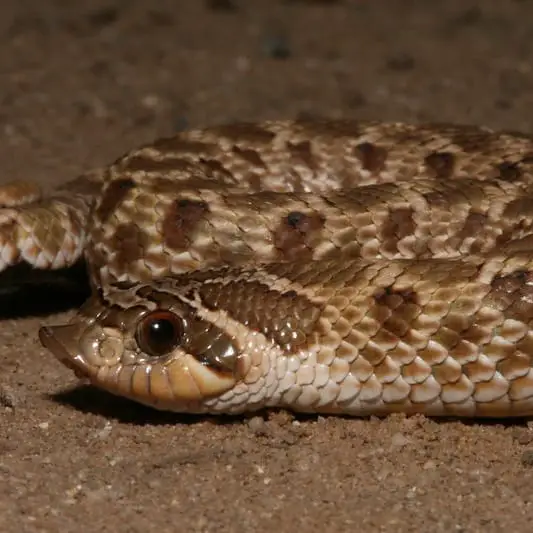The western hognose snake, Heterodon nascius, is a harmless snake that can be found throughout the Central United States as well as Canada and Mexico. The appearance and behavior of this relatively small and brown snake is adapted to the venomous rattlesnakes found in the same gepgraphic range. This mimickry intimidates and scares off potential predators.
Description
The hognose snake got its common name from its hog-shaped Scutum rostrale (the nasal scute). This modification allows the snake to better dig into loose soil. The base coloration of the snake is usually light brown for adults and cream-colored or even white for juveniles.
The snake has two rows of medium-sized darker brown blotches along its back. Along the sides, there are several more smaller dark blotches or spots.

It appears that the snake has adapted its appearance as well as some behavior to rattlesnakes. This so-called Batesian mimickry scares off potential predators who aren’t willing to take on a venomous rattlesnake. Due to its size, the snake can be confused with the pygmy rattlesnake (Sistrurus miliarus) as well as the larger and non-venomous Pacific gopher snake (or bullsnake) who also mimicks the appearance and bahavior of rattlesnakes.

Size
Western hog-nosed snakes usually reach a body length of 18-24 (45-60) cm and a maximum of 35 inches (90 cm). This snake shows a a distinct sexual dimorphism. Meaning that females are much larger and considerably heavier than males.
Hunting Behavior and Habitat
Due to their size, hognosed snakes feed mainly on medium-sized reptiles. Their main diet consists of frogs, toads and lizards. After fixating their prey with a bite, they will “chew” on the living prey. This is to massage their venomous saliva into the prey’s system. Prey animals are eaten whole, head first.
Bite and Defense
Hognose snakes have a mildly venomous saliva. However, due to the almost non-existing effects on humans, this species is still considered a nonvenomous snake. No systemic effects of a hognose snake bite have ever been recorded. The snake would have to keep “massaging” their saliva into under the skin for an extended period of time for the venom to show any effects on humans. Allergic persons should still steer clear of the snake to prevent an unlikely, but possible reaction to the mild venom.
Hog-nosed snakes have an impressive defensive behaviour. If they feel threatened, they will bend their neck into an S-shape to strike like a rattlesnake. However, when they strike larger attackers, they are keeping their mouth closed and basically punch their attacker. The nonvenomous western gopher snake shows a similar behavior. If the attacker still won’t back up after this, it will turn on its back and release a foul smelling, milky white liquid from its anal vent. In addition, it can bleed from the mouth by intentionally rupturing smaller blood vessels. By feigning dead, it confuses predators and presents itself as inedible.

Western hognose snake range in the USA
Next to Canada and Mexico, the western hognose snake can be found in the following area in the United States: Montana, North Dakota, South Dakota, Nebraska, Eastern Wyoming, Illinois, Eastern Colorado, New Mexico, Kansas, Oklahoma, Texas and Western Minnesota.
Subspecies of Heterodon nasicus and their range
- Heterodon nasicus gloydi – Gloyd’s hognose snake (Southeastern Kansas, Southeastern Missouri, Eastern Oklahoma, Texas)
- Heterodon nasicus kennerlyi – Mexican hognose snake (Mexico, Southwestern New Mexico, Southeastern Arizona)
- Heterodon nasicus nasicus – Plains hognose snake (Texas, New Mexico, Western Oklahoma, Western Kansas, Minnesota, Illinois, South Dakota, North Dakota, Montana, Nebraska, Wyoming, Colorado, Canada
Other Common Names
Other common names of the hognose snake include various different spellings of its standard common name: hog-nose snake, hog-nosed snake and hognosed snake. In addition, the snake is sometimes referred to as one of the following: bluffer, spreadhead snake, faux viper, spoonbill snake, prairie hognose snake, Texas hognose snake, and Texas rooter.
Scientific classification of Heterodon nasicus
- Kingdom: Animalia
- Phylum: Chordata
- Class: Reptilia
- Order: Squamata
- Suborder: Serpentes
- Family: Colubridae
- Genus: Heterodon
- Species: Heterodon nasicus
